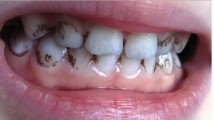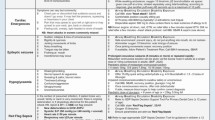Abstract
Data sources
The electronic databases searched included: PubMed/MEDLINE, Cochrane Central Register of Controlled Trials (Central) and Web of Science until June 2015. There was no restriction to language and the reference lists from relevant studies were searched for further articles.
Study selection
Randomised and prospective controlled trials that compared the effect of submucosal injection of dexamethasone with that of placebo after impacted third molar surgery in humans. Studies involving volunteers with decompensated metabolic disease were excluded.
Data extraction and synthesis
Study selection, data extraction and quality assessment (risk of bias) were assessed by two reviewers. All disagreements were resolved through discussion. A meta-analysis was performed for all continuous variables (oedema, pain and trismus) when at least two of the studies analysed the same data type.
Results
Eight studies involving a total of 476 patients of which six were included in the meta-analysis. All of the surgical procedures were performed on the lower molars, submucosal injections of dexamethasone were used in concentrations of 4 mg, 8 mg, or 10 mg, and saline was used as a control. Antibiotic medications were administered prophylactically before surgery or by continuous use after the procedure. Seven of the eight studies identified the impactions according to the Pell and Gregory Classification. Oedema was measured using facial contours of pre-established reference points. The meta-analysis presented a mean difference (MD) of −2.20 (95% CI −2.70 to −1.70), with a statistically significant difference favouring dexamethasone (P< 0.00001). Trismus (assessed using inter-incisal distance upon maximum opening) had a MD of −2.92 (95% CI −7.13 to 1.29) and showed no statistically significant difference between groups. Pain was assessed using both visual analogue scales and number of analgesic taken; however, only studies including a VAS were used for meta-analysis. Pain presented with a MD of −1.79 (95% CI −3.28 to −0.30) and showed a statistically significant difference favouring dexamethasone.
Conclusions
The review found moderate quality evidence that submucosal injections of dexamethasone reduced post-operative oedema and pain compared to a placebo following impacted third molar surgery. There was no significant difference, in regards to trismus, between placebo and dexamethasone.
Similar content being viewed by others
Commentary
Surgical extraction of impacted third molars is one of the most frequent surgical interventions in dentistry. Any intervention that could mitigate the inflammatory response could help with common post-operative symptoms of swelling, pain and trismus. A reduction in these symptoms would have an immediate positive impact on a patient's post-operative comfort. There are numerous studies in the literature assessing the administration of corticosteriods after third molar extraction, but most have focused on systemic administration. The main advantage of a submucosal route is the concentration is applied close to the surgical site and there is low systemic absorption.
A systematic review with meta-analysis was performed by the authors attempting to identify whether dexamethasone could be injected into the submucosa to control post-operative symptoms. The search resulted in eight articles ranging from 2006 to 2014. This search strategy appears to have produced a limited number of articles from a narrow time frame. It is possible that some studies relevant to the topic were missed.
The methodologies of the included RCTs were of low-to-moderate quality. There were some concerns regarding bias (particularly adequate sequence generation and allocation concealment). Additionally, the authors expressed concern about blinding for volunteers, surgeons and statisticians. It appears to be a lack of adequate reporting rather than proper study design and did hinder methodological analysis of all the articles. Additionally, the authors used a funnel plot to assess the risk of publication bias. Two studies were identified as contributing to the asymmetry. One, in particular, demonstrated a wide confidence interval and could skew the results to favour the use of dexamethasone. Despite these limitations there were positive correlations between the submucosal injection of dexamethasone in reducing postoperative pain and oedema. Both of these symptoms had statistically significant results. Alternatively, there was no statistically significant result found for the reduction of trismus. It should be noted that all measure outcomes had a high heterogeneity. Each outcome had I2 values of 87% for edema, 97% for trismus and 77% for pain, indicating a high variability in the interventions between the included studies. This lowers the belief that the favourable outcome was due to the intervention alone.
Overall, a practitioner would be cautious to introduce the submucosal injection of dexamethasone for post-operative pain and oedema in their practice, and there is no evidence that dexamethasone aids in post-operative trismus. The results were statistically significant favouring the implementation of dexamethasone; they may not be clinically significant. For example, pain was compared using a VAS scale (1-10) and only showed a mean difference of −1.79. This makes interpretation challenging since each patient may interpret pain differently and this magnitude of change may or may not be felt. Alternatively, it is unknown if this magnitude of change could be managed sufficiently with analgesics and anti-inflammatories to a similar effect. Finally, this review did not discuss any side effects or negative sequelae due to the use of dexamethasone. Without this knowledge it is difficult to assess the benefits to the patient in comparison to the potential adverse outcomes.
Author information
Authors and Affiliations
Additional information
Address for correspondence: Vittorio Moraschini, Department of Periodontology, School of Dentistry, Fluminense Federal University, Rua Mario dos Santos Braga, 30 Centro Niteroi, Rio de Janeiro, Cep 24010-140 Brazil. E-mail: vittoriomf@terra.com.
Moraschini V, Hidalgo R, Porto Barboza ED. Effect of submucosal injection of dexamethasone after third molar surgery: a meta-analysis of randomized controlled trials. Int J Oral Maxillofac Surg 2016; 45: 232–240.
Rights and permissions
About this article
Cite this article
Freda, N., Keenan, A. Moderate evidence to recommend submucosal injection of dexamethasone in reducing post-operative oedema and pain after third molar extraction. Evid Based Dent 17, 58–59 (2016). https://doi.org/10.1038/sj.ebd.6401174
Published:
Issue Date:
DOI: https://doi.org/10.1038/sj.ebd.6401174



